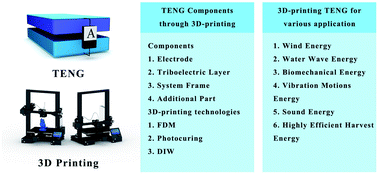Rapid prototyping and customizable multifunctional structures: 3D-printing technology promotes the rapid development of TENGs
Abstract
The development of the IoT and portable devices has triggered the relentless pursuit of self-powered systems to solve the limitations of conventional power-supply methods. As a novel energy-conversion technology, triboelectric nanogenerators (TENGs) have great advantages in terms of material selection, structural design, and functional applications, and they can meet different size and application-scenario requirements. However, the need for undesirable numbers of manufacturing and assembly steps has become a major obstacle to their further development, preventing high efficiency and industrialization. The emerging advance of 3D-printing technology provides the potential for the revolutionary prototyping and simplified fabrication of TENGs with distinctive structures, including triboelectric layers, electrodes, device frames, additional parts, etc. Herein, this review focuses on the roles played by different printing methods in the preparation of TENG components. Meanwhile, we summarized a series of TENGs with distinctive structures obtained using 3D printing for various energy-harvesting and functional scenarios. Finally, current technical barriers were discussed and future development trends were evaluated involving the combination of 3D-printing technology and TENGs. It is obvious that 3D-printed TENGs will provide a low-cost, facile, and efficient approach for obtaining self-powered systems and this will further broaden the functional applications of TENGs.

- This article is part of the themed collection: Journal of Materials Chemistry A Recent Review Articles


 Please wait while we load your content...
Please wait while we load your content...